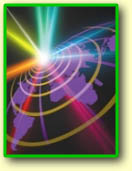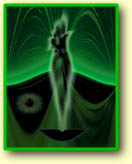|
The development of
holography has given a very effective way of creation of qualitative three-dimensional
images. The new independent area of holographic creative work - representational
holography has appeared. Artistic holography as important style in this
holographic area has become a new kind of fine arts.
Contents
Holography and Artist
The first artist, who
used amazing properties of the holograms, was Salvador Dali. He always was enthusiastic
about optics in general and opportunities of its application for creation of volumetric
illusion. Before invention of the laser and its use in holography, the stereoscopic vision
was most suitable for purposes, Dali planned. And it is quite natural, that his aspiration
to take possession of the third dimension, became paramount importance for him.
So, the first stage on
this way has become 1964, when he has brought from New York plastic panels, consisting of
fine cells. These panels covered one another and created embossing effect. This
"moire", reminded eye of an insect, formed the basis for several picturesque
works, like "A landscape with the flies" and " Laokoon, tormented by the
flies". In 1970 in Louvre Museum of Paris (France) he studied pictures of Gerard Dow,
contemporary of Wermer. Dali learned, that Dow wrote down six stereoscopic, or double
pictures. Most remarkable of them represents the boy who has caught the mouse; one of them
is in the Dresden Gallery (Germany), another - in St.-Petersburg (Russia). When he made
this invention, he started his work at the stereoscopic images. The effect was achieved by
reflection of two mirrors located under the angle 600 to each other. Using this reception he created two small double pictures represented Gala (his wife), in
workshop of the Port-Ligatta. Then he carried out two engravings - first stereoscopic
"estamp" - for the book "Ten recipes of immortality". At the same time
he tried to simplify reception allowing at once several spectators to see a picture in the
three-dimensional image through lenses of Fresnel. When the American scientist Dennis Gabor got the Nobel Prize for invention of the holography,
Dali felt in this invention the best way for the progress on his path to emboss image. In
the beginning of 1972 due to advice of Dennis Gabor he created three compositions, which
were exhibited from April 5 till May 13 in the Nedler's Gallery of New York. In the
introduction to the catalogue of this exhibition, he explained, what is holography for the
artist: "The three-dimensional reality interested artists from the age of Velaskes;
presently analytical cubism of Picasso has tried to take possession of Velaskes's 3-D
reality. Now, due to the genius of Gabor, holography has made possible art renaissance,
and the doors of a new area of creativity have opened ahead of me".-->
Using this reception he created two small double pictures represented Gala (his wife), in
workshop of the Port-Ligatta. Then he carried out two engravings - first stereoscopic
"estamp" - for the book "Ten recipes of immortality". At the same time
he tried to simplify reception allowing at once several spectators to see a picture in the
three-dimensional image through lenses of Fresnel. When the American scientist Dennis Gabor got the Nobel Prize for invention of the holography,
Dali felt in this invention the best way for the progress on his path to emboss image. In
the beginning of 1972 due to advice of Dennis Gabor he created three compositions, which
were exhibited from April 5 till May 13 in the Nedler's Gallery of New York. In the
introduction to the catalogue of this exhibition, he explained, what is holography for the
artist: "The three-dimensional reality interested artists from the age of Velaskes;
presently analytical cubism of Picasso has tried to take possession of Velaskes's 3-D
reality. Now, due to the genius of Gabor, holography has made possible art renaissance,
and the doors of a new area of creativity have opened ahead of me".-->
|





